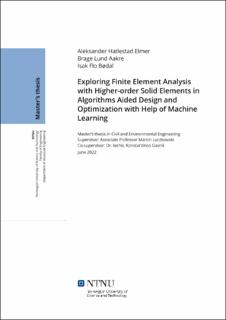| dc.contributor.advisor | Luczkowski, Marcin | |
| dc.contributor.advisor | Gavriil, Konstantinos | |
| dc.contributor.author | Aakre, Brage Lund | |
| dc.contributor.author | Bødal, Isak Flo | |
| dc.contributor.author | Elmer, Aleksander Hatlestad | |
| dc.date.accessioned | 2022-10-05T17:19:17Z | |
| dc.date.available | 2022-10-05T17:19:17Z | |
| dc.date.issued | 2022 | |
| dc.identifier | no.ntnu:inspera:107175085:66136892 | |
| dc.identifier.uri | https://hdl.handle.net/11250/3024149 | |
| dc.description.abstract | Denne masteroppgaven utforsker mulighetene ved å implementere Elementsanalyse med volumelementer i program som benytter seg av Algorithms Aided Design (AAD). AAD er en metode for å bruke algoritmer og parametere til å lage 3D modeller. I denne oppgaven blir programmet Grasshopper brukt. Videre ser oppgaven på å erstatte de mer komplekse delene av elementanalysen med Maskinlæring (ML). ML blir brukt for å effektivisere deler av analysen, eller til å løse oppgaver som er for komplekse til å bli løst av en algoritme med faste regler. Oppgaven består av syv case studier som utforsker følgende problemstillinger.
Hva er mulighetene og utfordringene ved å implementere elementanalyse med volumetriske elementer i et Algorithms Aided Design program?
Kan deler av, eller hele, analysen erstattes med maskinlæring?
For å svare på den første problemstillingen har to ulike programvareutvidelser til Grasshopper, som gjennomfører elementanalyse, blitt utviklet. Den første av disse er utviklet i sin helhet av oppgavens forfattere, mens den andre er en videreutvikling av en allerede etablert programvare. Disse to programvarene viser hvordan implementeringen av elementanalyse i AAD effektiviserer designprosessen. En av de største fordelene ved å jobbe i Grasshopper er muligheten til å raskt gjøre endringer på geometrien til en modell. Den andre programvareutvidelsen som ble utviklet viser fordelene ved å bruke elementer med høyere-ordens formfunksjoner i analysen. Dette spesielt på kompleks geometri, som er vanlig å lage i AAD programmer.
Videre ble det utviklet en rekke ML modeller for å svare på den andre problemstillingen. En av de største utfordringene i elementanalysen er å lage et godt mesh, spesielt for kompleks geometri. Det har derfor blitt utforsket å bruke ML til å forbedre denne prosessen. I tillegg har det blitt sett på å erstatte hele elementanalysen med ML, samt å bruke ML til å predikere rotasjonsstivheten til en forbindelse.
Alle ML-modellene i denne oppgaven gir positive resultater. Oppgaven med å finne plasseringene til nodene i meshet er løst både i 2D og i 3D. For å kunne generere ett fullstendig mesh, må metoden utvikles ytterligere. Resultatene når ML blir brukt på hele elementanalysen er gode for spenninger, mens det for deformasjoner kreves forbedring før resultatene er tilfredsstillende.
Det er tydelig at å bruke ML til å gjennomføre deler av, eller hele, elementanalysen vil forbedre effektiviteten. I tillegg viser implementeringen av elementanalyse som støtter volumetriske elementer hvordan designprosessen i AAD program kan forbedres og effektiviserer. | |
| dc.description.abstract | This thesis explores the possibilities of Finite Element Analysis (FEA) with solid elements in an Algorithms Aided Design (AAD) environment. An AAD environment is a program that uses an algorithmic approach with parameters to create 3D models. In this thesis, the AAD program used is Grasshopper. Furthermore, the advantages of applying Machine Learning (ML) to some of the more challenging steps when implementing the FEA in Grasshopper has been investigated. ML is applied to make parts of the analysis more efficient, or to solve problems that are too complex to solve in a satisfying manner with a program that uses fixed rules. The thesis consists of seven case studies designed to explore the following research questions.
What are the possibilities and issues of Finite Element Analysis with solid elements in an Algorithms Aided Design environment?
Can parts of, or the whole, Finite Element Analysis be replaced by machine learning?
To answer the first research question, two different finite element plugins for Grasshopper are developed. The first is fully developed by the authors of this thesis, while the second plugin is a further development of an already established plugin. These plugins illustrate how the implementation of FEA in Grasshopper makes the design development process more efficient. One of the greatest benefits of working in Grasshopper is the ability to rapidly make changes to the geometry. The plugins developed in this thesis improve the design process by adding the option to perform an FEA with solid elements. The second plugin also highlights the benefits of implementing higher-order elements in an AAD environment, where we often find more complex geometry.
A series of ML models are developed to answer the second research question. One of the most challenging steps in the FEA is preprocessing of the model, especially meshing of complex geometry has proven to be challenging. Therefore, the meshing process is one of the tasks investigated with the help of ML. The thesis also explores if ML can be used to replace the entire FEA, and if it can be used to predict the rotational stiffness of a connection.
All the ML models included in this thesis show promising results. The problem of finding the location of mesh vertices is solved for both 2D and 3D. To create complete meshes, the method would need more development. For the entire FEA problem, the results show accurate predictions for stresses, while the predicted displacement needs some further improvement before the results are satisfactory.
In general, it is clear that the use of ML in the FEA workflow will improve the efficiency and accuracy of the analysis. Furthermore, the implementation of the FEA illustrates the possibilities of improving the rapid design process in an AAD environment. | |
| dc.language | eng | |
| dc.publisher | NTNU | |
| dc.title | Exploring Finite Element Analysis with Higher-order Solid Elements in Algorithms Aided Design and Optimization with Help of Machine Learning | |
| dc.type | Master thesis | |
